 |
 |
READ THIS FIRST:
WORKING UNDER A VEHICLE CAN BE HAZARDOUS OR DANGEROUS AND CAUSE INJURY OR DEATH. EVEN QUALITY JACK STANDS CAN COLLAPSE IF NOT POSITIONED PROPERLY, AND A FLOOR JACK CAN FAIL SUDDENLY AND WITHOUT WARNING. IF YOU DO NOT HAVE THE SKILL OR PROPER TOOLS TO PERFORM THIS TASK, PLEASE SEEK PROFESSIONAL ASSISTANCE.
THE USE OF THIS DIY IS FOR YOUR REFERENCE ONLY. I DISCLAIM ALL LIABILITY FOR DIRECT, INDIRECT, INCIDENTAL, OR CONSEQUENTIAL DAMAGES OR INJURIES THAT RESULT FROM ANY USE OF THE EXAMPLES, INSTRUCTIONS OR OTHER INFORMATION IN THIS DIY.
This takes 10 - 20 minutes and is inherently a process that requires your utmost attention. Doing things safely is far more important than quickly. If you're planning on putting your body under 3,500 of metal you are far better off to take your time and make sure everything is secure before you do so.
Raising up an M3 has the same inherent difficulties as most other low slung sports cars - the car simply sits too low for most jacks to comfortably get underneath without the need to first raise the car a bit off the ground - thus the additional complication shown here.
Also, if your jack has a large lifting base (the round thing that pushes the car up) you may want to place a piece of wood or some other suitable material in there to protect the under tray of the car.
Click on the images for larger views. |
WARNING:
- MOST IMPORTANTLY - NEVER EVER GET UNDER YOUR CAR WHEN ITS SUPPORTED SOLELY BY A JACK!!!!! Never trust a jack - I don't care how nice or expensive it is.
- The car must be parked on a level surface. Cement is probably a much better base for your jack stands than asphalt.
- E46 M3 Jack Pads have a nasty reputation for collapsing even when jack stands or jacks are used correctly. A severe collapse could probably cause the car to become unstable and possibly fall - this can, in simple terms kill or severely injure you.
- If your car was recently driven, there is a pretty good chance of burning yourself when raising up the rear end - be carefull when working around the exhaust.
|
Step 1: Getting the required items together
This job requires:
- 1 Hydraulic Jack (at least 1.5 ton)
- 4 Jack Stands
- Depending on the height of your jack:
- 2 Rhino or similar ramps and 2 2"X10"X24" (my scenario)
- 4 2"X10"X24"
- Depending on your jack you may want to get a piece of wood to fit in the raising surface on the jack (in my case I cut a 5" diameter, 1" piece of wood that works like a charm).
- A BMW M3 (E46).
- 10 - 20 minutes of free time.
|
 |
|
Step 2: Drive Car Up On Ramps
- If you need an explanation as to how to do this - stop now and take your car to the shop to do whatever work you were planning.
|
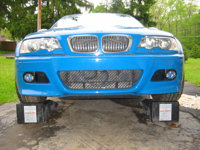
Front End On Ramps |
Step 3: Place 2X10's Under Rear Wheels
- There is a reason for this madness - to get to the jacking point (subframe just in front of the differential) without getting the extra room provided by a set of 2X10 is a major pain in the ass and likely impossible with the majority of regular hydraulic jacks (race jacks may have an easier time). By giving yourself an extra bit of room you make your job a lot easier.
- Make sure your car is in gear and e-brake is on.
- Find the Jack Pad (point) about a foot ahead of the rear wheel well - its a black rectangualar plastic piece that sits about an inch in from the edge of the side skit that you can easily see and feel.
- Make sure you ALWAYS jack up the side of the car using the jack pads to avoid doing damage to the vehicle itself.
- Jack up just enough to slide the 2X10 under the tire.
- Lower on to the 2X10.
- Repeat for other side.
|

Rear Tire On 2X10
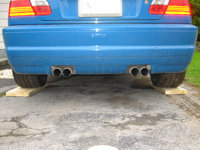
Rear End On 2X10's |
Step 4: Jack Up Rear of the Car
- Jack up the rear end from the back of the car.
- Look under the car and note the subframe directly in front of the differential. This is where the jack should go. (see images) DO NOT JACK UP BY THE DIFFERENTIAL!
- Carefully jack up the rear of the car enough to get your jack stands into position (see next step).
|
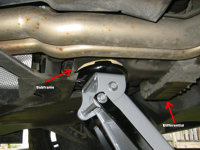
View from Right Side
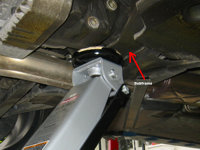
View from Left Side |
Step 5: Setting the Rear on to Jack Stands
- Once you have jacked the rear end up high enough to get your jack stands under the jack points (pads).
- Find the rear jack points again and set your jack stands securely in place - make sure they are on level and solid surfaces.
- SLOWLY lower the car down on the jack stands - if you sense ANY trouble - stop and raise the car back up and double check your jack stands.
|

Rear Jack Stand in Place |
Step 6: Jack Up the Front End
- Insert the jack from the front of the car.
- Note the round plastic jack point in the center just behind the large front plastic shield (see image)
- Jack up the car high enough to get your jack stands under the front jack points (same a rear jack points - just about a foot rear of the front wheel wells).
|
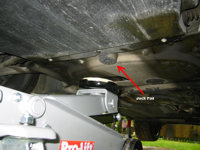
Front Center Jack Point |
Step 7: Setting the Front on to Jack Stands
- Once you have jacked the front end up high enough to get your jack stands under the jack points (pads).
- Find the front jack points again and set your jack stands securely in place - make sure they are on level and solid surfaces.
- SLOWLY lower the car down on the jack stands - if you sense ANY trouble - stop and raise the car back up and double check your jack stands.
- Once the car is sitting on 4 jack stands, you can remove the ramps from under the front wheels.
-
|
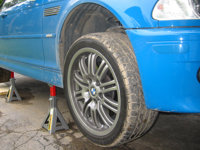
Car up on Jack Stands |
Step 8: Lowering the Car Back Down
- Start at the front by placing ramps back under the front wheels - make sure you line them up well as they will not be adjustable once the car is on them.
- Jack up the front end at the same location as before just enough to remove the front jack stands.
- Once the front jack stands are removed, gently lower your front wheels back on to the ramps.
- Make sure the 2X10 are still under the rear wheels.
- Jack up the rear end at the same location as before just enough to remove the rear jack stands.
- Remove the rear jack stands and slowly lower the rear wheels back on to the 2X10's.
- You do not have to jack up the sides to remove the 2X10's.
- Drive the car back off the ramps and 2X10's and you're all set.
|
|

|







